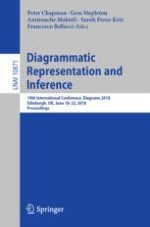2018 | OriginalPaper | Chapter
The Effect of Graphical Format and Instruction on the Interpretation of Three-Variable Bar and Line Graphs
Authors : Nadia Ali, David Peebles
Published in: Diagrammatic Representation and Inference
Publisher: Springer International Publishing
Activate our intelligent search to find suitable subject content or patents.
Select sections of text to find matching patents with Artificial Intelligence. powered by
Select sections of text to find additional relevant content using AI-assisted search. powered by
